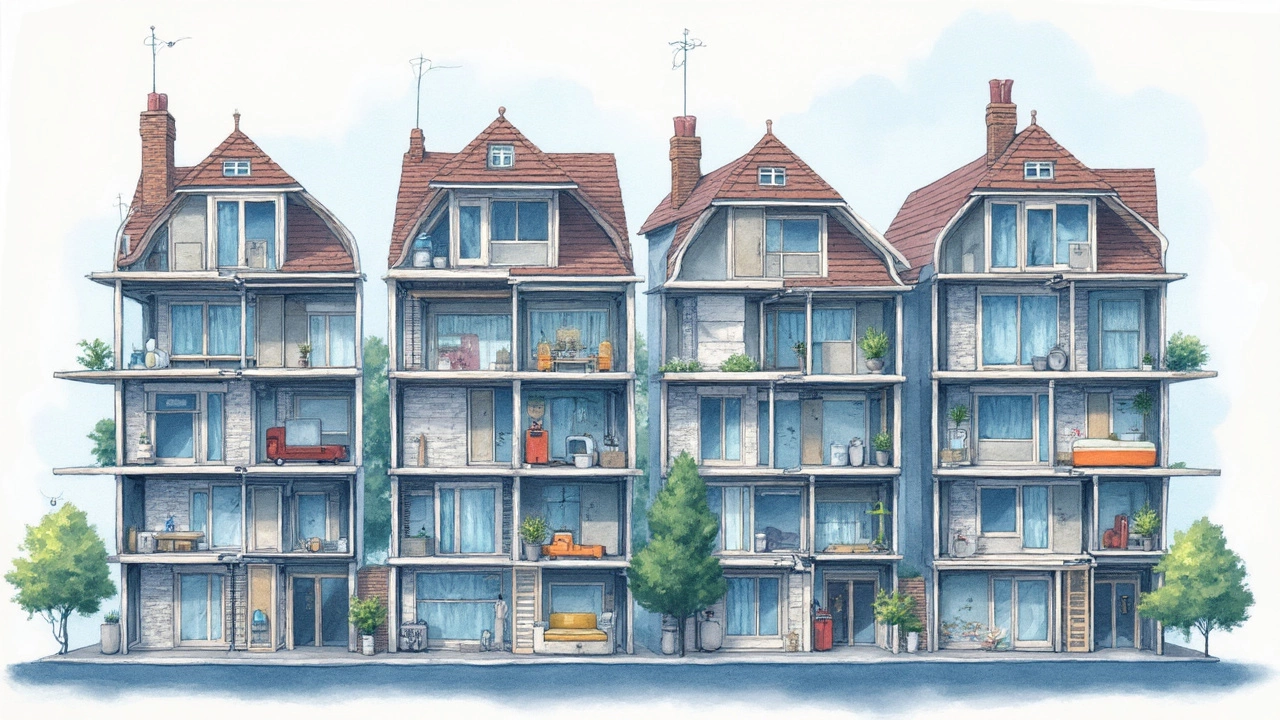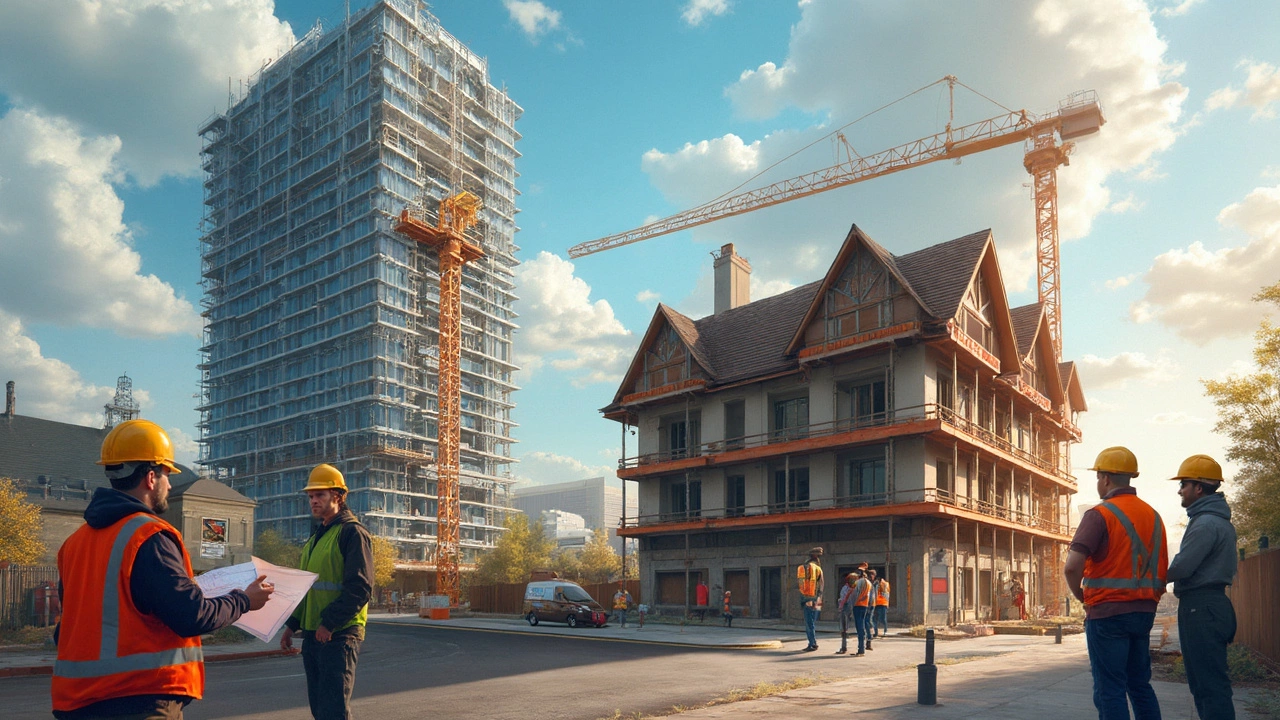Ever walked into a commercial building and wondered what holds the place up? Most people don’t give much thought to the nuts and bolts—until there’s an insurance form to fill out, or you’re talking to a fire marshal. The construction type of a commercial building can affect everything from how much it costs to insure the place, to what upgrades you’ll need for fire safety and renovations.
Here’s the kicker: building codes aren’t just red tape, they’re what keeps people safe and businesses running. Getting the construction type wrong on paperwork can even cause issues with claims and permits. If you’re about to lease, buy, or build a commercial space, knowing the difference between, say, a Type I fire-resistant high-rise and a more flammable wood-frame shop could save you a headache—and some serious cash down the line.
- Why Building Type Matters for Your Business
- Breaking Down Commercial Construction Types
- How to Identify Your Building’s Construction Type
- Tips to Pick the Right Construction Type for Your Project
Why Building Type Matters for Your Business
Let’s get real—what your building is made of has a huge impact on your business. The first thing to know: city building departments put every commercial structure into a construction type category. This isn’t some random label. It drives how strict the local codes are for your space, what fire protection measures you’re forced to add, and which upgrades will cost you the big bucks.
If you’re dealing with insurers, expect them to ask for your commercial construction type right away. Why? Structure type can change your insurance premium by thousands per year. For example, Type I buildings—mostly concrete and steel—are tough against fires, so insurance tends to cost less. On the flip side, Type V buildings, which use wood framing, can see higher costs due to fire risk.
It also affects your options when it comes to renovations or tenant improvements. Some cities place tight limits on what you can change in a wood-framed building compared to a steel one. You might even hit a wall with occupancy limits—tech offices in Type II steel structures can often pack in more people safely than those in less protected types.
Another thing: business interruption from disasters like fire or floods plays out differently depending on your building type. Repairs for a Type III brick structure usually wrap up faster than a complex high-rise. That means less downtime, which is pretty important when every week closed costs you money.
So, knowing your building’s construction type isn’t just trivia. It affects what you pay, how you grow, what’s allowed by code, and how quickly you can bounce back when things go wrong. That’s why getting it right matters from day one.
Breaking Down Commercial Construction Types
So what exactly are the options out there when it comes to commercial construction types? The International Building Code (IBC) splits them into five main categories: Type I, Type II, Type III, Type IV, and Type V. Each one is based on the fire-resistance and materials used, not just how fancy a building looks.
Type I: Fire-Resistive. These are your classic high-rise office towers and hospitals, built with substances that won’t catch fire easily, like concrete and protected steel. The bones and the floors are rated for at least two hours of fire resistance. This is why you can cram a lot of people and equipment in safely, but it also bumps up costs.
Type II: Non-Combustible. These buildings use the same materials as Type I—mostly steel and concrete—but don’t go all-in on fireproofing. You’ll find schools, newer warehouses, and shopping centers in this group. The key difference is that the structural elements don’t last as long in a fire, though they don’t add fuel.
Type III: Ordinary Construction. Think old brick buildings or those strip malls with block walls and wooden roofs. The outside walls are non-combustible, but the inside stuff (floors, roofs) can be wood. These are everywhere in cities, especially in older neighborhoods.
Type IV: Heavy Timber. This one’s making a comeback thanks to mass timber. It uses chunky wood columns and beams that are surprisingly good at holding off fire. Type IV was big in warehouses and mills built before modern codes, but you’ll see new ‘eco-friendly’ offices using this style now too.
Type V: Wood Frame. This is the lightest and cheapest option, using wood (sometimes engineered) for everything—walls, floors, and roof. It’s quick to build, which is why you see new apartments and smaller office buildings going this route. But it’s also the most at-risk for fires, so insurance tends to cost more.
If you’re trying to figure out what type a building falls into, look up, look down, and look around at the structure and materials. Knowing the differences can shape everything from your design to your bottom line.

How to Identify Your Building’s Construction Type
So, you need to figure out what construction type your building is? It’s not as mysterious as it sounds. First, check your property paperwork—sometimes it’s right there in the plans or insurance docs. But don’t trust every old report. Codes and classifications change, and the materials you see in the lobby might not match what’s hidden above the ceiling tiles.
If you want to get hands-on, here’s what you can do:
- Look at the bones: Head to the mechanical room or a spot where you can see unfinished walls and ceilings. Are the beams steel, concrete, or wood?
- Check for fireproofing: Type I buildings, like urban high-rises, usually have thick concrete columns and fireproof coatings on steel beams. Type III and V buildings often have wood structural elements, especially in roof and floor framing.
- Consider the era: Buildings from the 1970s and later are more likely to use concrete and steel for structural elements. Older spots, especially in smaller towns or neighborhoods, often rely on heavy lumber or brick.
If you’re still stumped, your local building department is your best friend. They keep permits and plans on file. Or, call a structural engineer—they know the difference between a fire-resistant steel frame and a basic wood joist at a glance. According to the International Code Council,
“Most building codes classify construction based on the combustibility and fire-resistance of a building’s structural elements. This isn’t just technical detail—it affects how the building is protected and insured.”
One last thing: the main commercial construction type for a property is based on its supporting structure, not just how the walls look. You might have fancy stone facing, but if the frame is wood, that’s what matters for safety and insurance. Take the time to double-check. It can save you a big headache if there’s ever a claim or renovation on the horizon.
Tips to Pick the Right Construction Type for Your Project
Nailing the right construction type calls for more than eyeballing a blueprint. The decision can impact your costs, safety, and how easy it’ll be to keep the place open for years. Trying to save up front with the cheapest option often backfires when stricter codes, high insurance premiums, or upgrades catch up later on. Here’s what you need to look at before you break ground:
- Commercial construction type should match your business’s needs. For example, restaurants and warehouses have totally different safety hazards. Know your business before narrowing down walls and beams.
- Building codes in your city or county will tell you which construction types you’re allowed to use — and what’s expected in terms of fire resistance, accessibility, and wind load requirements. Skipping this step leads to failed inspections or costly changes later.
- Upfront versus long-haul costs aren't always obvious. Steel-frame buildings are pricier right off the bat but often last longer, outclassing cheaper wood frames, especially when it comes to repairs after a storm or fire. Here’s a breakdown of rough cost and durability comparisons:
| Construction Type | Average Cost per Sq Ft | Expected Lifespan | Insurance Savings |
|---|---|---|---|
| Steel Frame | $40 - $80 | 50+ years | High (due to fire/impact resistance) |
| Concrete | $60 - $100 | 60+ years | Very High (lowest risk) |
| Wood Frame | $20 - $50 | 30-50 years | Low (higher risk) |
| Masonry | $30 - $75 | 50+ years | Moderate-High |
- Ask your insurance agent for how different construction types affect your rates. It’s not uncommon to see lower insurance bills for fire-resistant options, sometimes by 20% or more.
- If you’re worried about future upgrades—adding solar, more stories, or swapping out tenants—go for flexibility. Concrete and steel buildings are usually easier to retrofit.
- Think about local weather and history. Areas with lots of storms or earthquakes do better with reinforced concrete or steel rather than wood or unreinforced masonry.
Bottom line: Don’t let cost be your only guide. Get input from experienced general contractors, local code officials, and business owners who’ve been through the process. The best fit balances what works for your business today and five, ten, twenty years from now—and keeps those inspection stickers coming with fewer surprises.
